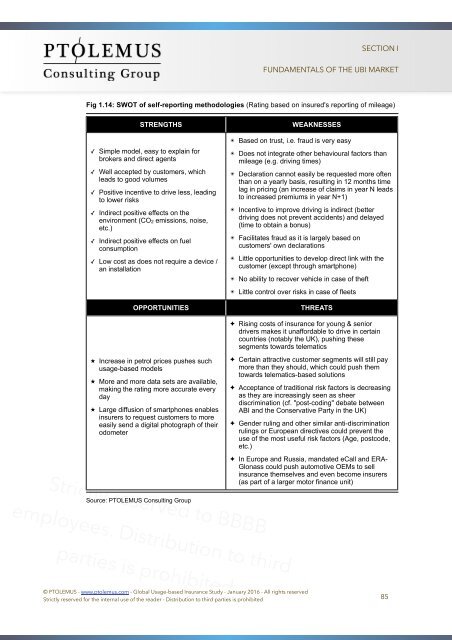AUTHORISATION
U1hB302Xjd2
U1hB302Xjd2
Create successful ePaper yourself
Turn your PDF publications into a flip-book with our unique Google optimized e-Paper software.
SECTION I<br />
FUNDAMENTALS OF THE UBI MARKET<br />
Fig 1.14: SWOT of self-reporting methodologies (Rating based on insured's reporting of mileage)<br />
STRENGTHS<br />
WEAKNESSES<br />
✓ Simple model, easy to explain for<br />
brokers and direct agents<br />
✓ Well accepted by customers, which<br />
leads to good volumes<br />
✓ Positive incentive to drive less, leading<br />
to lower risks<br />
✓ Indirect positive effects on the<br />
environment (CO2 emissions, noise,<br />
etc.)<br />
✓ Indirect positive effects on fuel<br />
consumption<br />
✓ Low cost as does not require a device /<br />
an installation<br />
OPPORTUNITIES<br />
★ Increase in petrol prices pushes such<br />
usage-based models<br />
★ More and more data sets are available,<br />
making the rating more accurate every<br />
day<br />
★ Large diffusion of smartphones enables<br />
insurers to request customers to more<br />
easily send a digital photograph of their<br />
odometer<br />
Strictly reserved to BBBB<br />
✴ Based on trust, i.e. fraud is very easy<br />
✴ Does not integrate other behavioural factors than<br />
mileage (e.g. driving times)<br />
Licence<br />
✴ Declaration cannot easily be requested more often<br />
than on a yearly basis, resulting in 12 months time<br />
lag in pricing (an increase of claims in year N leads<br />
to increased premiums in year N+1)<br />
agreement<br />
✴ Incentive to improve driving is indirect (better<br />
driving does not prevent accidents) and delayed<br />
(time to obtain a bonus)<br />
signed by<br />
✴ Facilitates fraud as it is largely based on<br />
customers' own declarations<br />
✴ Little opportunities to develop direct link with the<br />
customer (except through smartphone)<br />
AAAA. Reserved<br />
✴ No ability to recover vehicle in case of theft<br />
✴ Little control over risks in case of fleets<br />
THREATS<br />
for employees of<br />
✦ Rising costs of insurance for young & senior<br />
drivers makes it unaffordable to drive in certain<br />
countries (notably the UK), pushing these<br />
segments towards telematics<br />
BBBB<br />
✦ Certain attractive customer segments will still pay<br />
more than they should, which could push them<br />
towards telematics-based solutions<br />
✦ Acceptance of traditional risk factors is decreasing<br />
as they are increasingly seen as sheer<br />
discrimination (cf. "post-coding" debate between<br />
ABI and the Conservative Party in the UK)<br />
✦ Gender ruling and other similar anti-discrimination<br />
rulings or European directives could prevent the<br />
use of the most useful risk factors (Age, postcode,<br />
etc.)<br />
✦ In Europe and Russia, mandated eCall and ERA-<br />
Glonass could push automotive OEMs to sell<br />
insurance themselves and even become insurers<br />
(as part of a larger motor finance unit)<br />
employees. Distribution to third<br />
Source: PTOLEMUS Consulting Group<br />
parties is prohibited<br />
© PTOLEMUS - www.ptolemus.com - Global Usage-based Insurance Study - January 2016 - All rights reserved<br />
Strictly reserved for the internal use of the reader - Distribution to third parties is prohibited 85


